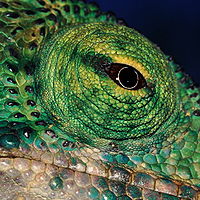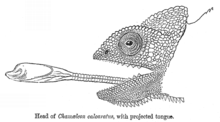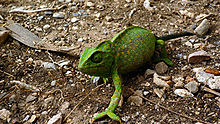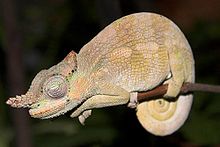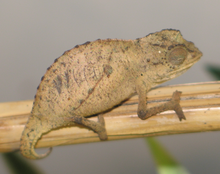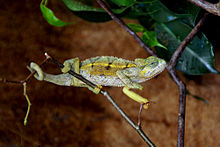Chameleons
| Chameleons | ||||||||||||
|---|---|---|---|---|---|---|---|---|---|---|---|---|
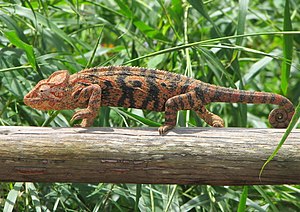
Giant chameleon ( Furcifer oustaleti ) |
||||||||||||
| Systematics | ||||||||||||
|
||||||||||||
| Scientific name | ||||||||||||
| Chamaeleonidae | ||||||||||||
| Werner , 1902 |
The chameleons (Chamaeleonidae) (Greek χαμαιλέων chamailéōn "earth lion") are a family of iguanas (Iguania) within the squamata (Squamata).
Over 200 species have been described, which are divided into two subfamilies: the real chameleons (Chamaeleoninae) and the stubby-tailed chameleons (Brookesiinae). Almost all chameleons are endangered in their natural habitat, which is why they come under the Washington Convention on Endangered Species and their keeping is therefore notifiable.
Origin and Evolution
The earliest fossil-proven representative of the chameleons is Chamaeleo caroliquarti , a species that lived in Central Europe 26 million years ago and can already be classified in the genus Chamaeleo, which still exists today . However, it is very unlikely that it is a basal chameleon. There is a possibility that the family is significantly older and split off from the lineage of their closest relatives, the agamas , at the beginning of the Upper Cretaceous Period , almost 100 million years ago . The place of origin of the group is still unknown, although Madagascar , today still the habitat of most species, is often discussed as the evolutionary cradle of the family. However, there is no fossil evidence that could support the assumption. Finds from Asia and Europe lead to the conclusion that chameleons once inhabited an even larger area than they do today. However, the species that lived there died out, probably due to climate-related changes in habitat.
distribution
Chameleons are distributed across the entire African continent , including Madagascar , and are also found on the Arabian Peninsula and the Mediterranean . You can also find them in western India and Sri Lanka . In the meantime, however, certain species have also been introduced into the US states of Hawaii and Florida , where they do not inhabit ancestral habitats.
habitat
With a few exceptions, chameleons generally inhabit forested areas in warm regions. Dryness and humidity play a rather subordinate role. The two subfamilies of the group prefer different habitats:
The real chameleons are bush and tree dwellers. The physique has adapted to life in the treetops (grasping tail, grasping feet). However, among them there are also some species that inhabit the ground.
Among the earth or brookesiinae the hardwood and herbaceous layer is generally preferred as a habitat.
Chameleons inhabit various eco-zones . In the Sahara in the north of the range , some species live within the desert oases . In contrast, chameleons also exist in regions that are surprisingly cool for reptiles, such as Chamaeleo schubotzi , which lives on the snow line of Mount Kenya , 4500 m high . Another example of an unusually specialized species is Bradypodion occidentale , which inhabits the shell- gravel dunes of south-west Africa. It is not only particularly hot there, but also glistening because of the light floor and the reflection of the sun.
Nevertheless, it is sometimes difficult to assign a specific habitat to a specific species, since the living conditions in the range of the respective species are often highly variable.
features

Chameleons have some typical physical characteristics. Its compact torso, high back and compact skull are striking. The characteristic features also include their specialized, independently movable eyes, their grasping hands, the distinctive color-changing ability of most species and their long tongue that can be used for hunting. Chameleons can partially vary their body shape by puffing up or by spreading the lobes on the head ( physiophrenia ). This makes it difficult to pinpoint some species. The body shapes and characteristics are also highly variable within a species and depend on age and gender.
head
The head of the chameleon stands out due to its unusual shape and large eyes. In the subfamily of the real chameleons, more rarely also in the stump tail chameleons, it often wears a distinctive skull ornament, consisting of horns, snout extensions and characteristic helmet shapes that vary depending on the species. These fixed features make it easier to identify even very similar chameleon species. There are species that have very small snout processes ( Calumma nasutum ) or animals with a long snout process ( Calumma parsonii ). These appendages are an important factor for communication among animals. There are also horn-bearing species that can be easily distinguished by the number and shape of the horns. One subspecies, Trioceros quadricornis gracilior , has up to six horns, others like the well-known Trioceros johnstoni only have three or fewer.
The lizards also wear occipital lobes, a type of headdress. These flaps are spreadable and play a role in competitive battles. In addition, chameleons with splayed lobes appear larger and can intimidate potential predators.
The family is also characterized by the various dandruff combs that appear on the throat, stomach and, above all, on the back. The shape of the ridge varies greatly depending on the species. Either it is conical scales or spines that form it, or it resembles a sail in its shape, such as in Trioceros cristatus .
The helmet at the back of the head is a feature that all chameleons share. In some species it can grow up to 8 cm high, but in some cases it is hardly visible. Its function is to change the shape of the chameleon so that it looks more like a part of a plant than an animal. In addition to camouflage, the eye-catching helmets are also used for communication.
eyes
Chameleon eyes are a particularly typical feature of these lizards. They are considered to be very sophisticated and more powerful than the human eye . They also have a lens, but only the pupil is visible. Parts of the cornea are enclosed by scale-like eyelids, some of which have grown together with the eyeball. Visual acuity is caused by the cornea. An additional effect occurs through the eyelid hole and the pupil that is most comparable to a pinhole camera and, with the increase in the depth of field, has the effect of a stenopean gap . The animal can thus quickly recognize possible enemies and seek protection in the foliage. Another special feature is the chameleon eye's natural privacy screen. Tiny drops of oil can accumulate on the cones of the retina, which are also a sign of daytime activity and color vision, which protect adjacent optic nerves by weakening the incidence of light.
Another ability that only chameleons have in this form is the ability to move their eyes independently. The eyes are arranged in such a way that the fields of view can only overlap in a small area to form an image, which usually results in two individual images. However, it is still unknown how the two images are processed in the brain.
The unusual mobility of the eyes is ensured by a complex muscular system.
The use of the eyes in hunting follows a fixed pattern and applies to every species of chameleon:
- First, the entire area is searched independently of each other.
- If a prey animal is found, it is focused with both eyes.
The eyes literally protrude from the head. This increases the field of view considerably, vertically it is 90 °, horizontally 180 ° per eye. The result is a field of view of 342 ° with both eyes. This creates a blind spot of 18 ° that only covers part of the back.
Apart from the aspect of seeing, the eye also has the function of intra-species communication. By coloring the eye area, readiness for mating or recognition within the species is signaled.
To sleep, the eyes are lowered and the pupils are turned into a fold of skin in which they are protected with horn plates. Some species can also retract their entire eyes into their heads.
tongue
Their flinging tongue is also typical of chameleons. It is unique in its shape and can apply a tensile force of around 0.4 Newtons (Dischnerscher experiment with Chamaeleo montinum 1958). It can be one and a half times the length of the chameleon.
The tongue is contracted in the throat pouch on the hyoid bone , a sesamoid bone . It is not rolled up, but can be compared to a short piece of rubber band. The hyoid bone is equipped with two joints that can push the entire bone forward. If the tongue is fired, the hyoid bone is pushed forward and the muscles of the tongue are tensed, causing the tongue to pop out of the mouth. This process takes place in a tenth of a second. This means that the prey has only a very small chance of escaping.

Shortly before the tongue touches the prey, a muscle contracts at its thickened tip, creating a conical cavity. This creates a suction that draws the prey to the tongue. In addition, the tongue is moistened with a non-sticky secretion, which, however, increases the adhesive surface and therefore ensures that the chameleon can grasp the prey more easily. Finally, the tongue and its prey snap back into the lizard's mouth by contracting again.
- The five phases of shooting with the tongue
- The prey is fixed and checked for size, shape and type, determination of the distance between chameleon and prey
- The mouth opens slowly, the tongue is prepared and pushed forward a little
- The tongue is shot off
- The prey is recorded
- The prey is pulled into the mouth, held in the mouth while the tongue retracts into the throat pouch. Then the prey is swallowed whole
The tongue is also used to absorb water. Some species lick water from leaves, others use them as a water pipe by placing their tongues on branches or leaves over which water flows. So it runs down the tongue directly into the mouth.
Species that specialize in slow prey such as snails do not need tongue shot. They take the prey directly with their mouths.
Other features
The entire body of the real chameleon is designed for a life in the trees, although some species are almost exclusively ground-dwelling (e.g. Chamaeleo namaquensis ). With their bodies they imitate different parts of plants. With their bodies, the real chameleons are reminiscent of leaves and crown areas of trees, while the stump- tailed chameleons are more like old wood or leaves (e.g. Brookesia decaeyi ).
The feet are shaped like pliers, so that two or three toes are opposite each other. This makes reaching for branches much easier. Some species have strong claws that additionally secure the grip. The extremities have a special structure: in total, each foot has five toes, with two and three toes fused together. The rear feet are exactly the opposite of the front feet (2-3 3-2).
In addition to the extremities, the prehensile tail supports the climbing of the real chameleons. However, the tail cannot be thrown off ( autotomy ), as is the case with other lizard species. In stub-tailed chameleons, the tail, because it is relatively immobile, only has a supporting function.
When falling from a great height, chameleons can inflate their lungs and thus intercept the fall. The body size varies greatly within the family, with the males usually being larger than the females. The largest species are found in the subfamily of real chameleons, stubby-tailed chameleons remain significantly smaller, among them are also the smallest chameleons and some of the smallest amniotes .
The giant chameleon ( Furcifer oustaleti ) and Calumma parsonii reach a maximum total length of around 68 cm and are some of the largest species, in contrast to this, Brookesia micra, discovered in 2012, is the smallest chameleon at 3 cm.
The viscous saliva (400 times viscous than human saliva) enables chameleons to catch prey with a third of their body weight. Not sucking, as was previously thought, but the saliva serves to adhere the prey to the tongue.
Senses
While the sense of sight is particularly well developed, the chameleons' hearing is relatively poorly developed. An exception is the Chamaeleo namaquensis , which has become a ground dweller , whose hearing is significantly finer than that of other chameleons.
The nose only has a breathing function. Smelling happens, if it happens at all and is not a recessed sense, via the Jacobson organ .
Color change
In chameleons, the color change is not primarily used for camouflage, but primarily for communication with other species. The willingness to courtship , for example, is often accompanied by more conspicuous colors and patterns. The color also depends on external factors such as temperature, solar radiation, time of day or humidity. At high temperatures, the animals turn light in color to reflect the incident light. At low temperatures, they turn dark in color to absorb the energy of light. However, if it is exposed to too much sunlight, it turns black due to UV-absorbing melanins . At night it takes on very light colors. The colors become paler with age and illness. The spectrum of colors and patterns that is possible in principle is highly species-specific. Some species have a very small color spectrum (such as the stubby-tailed chameleons ) or cannot change their color at all. The color change takes place at different speeds depending on the type and situation. The colors change fastest in dangerous or combat situations.
The rapid, so-called physiological color change is made possible by active changes in color cells ( chromatophores ) located close to the surface, which are superimposed in layers under the epidermis . In the process, pigment- containing organelles within the cytoplasm of these dermal chromatophore cells are changed in shape and arrangement, spread out in a distributed manner (dispersion) or concentrated together (aggregation). Incident light can be reflected locally differently by different layers depending on the pigment, intracellular arrangement and cell location of the specific chromatophore types. The upper layer mostly contains xanthophores or erythrophores with a yellowish and reddish color from carotenoids . Underneath is a cell layer of melanophores with black-brown melanins . The color cells of the lowest layers are mostly guanophores and, thanks to the properties of their crystalline dye guanine , are able to refract incident light and create iridescent effects ( iridophores ). In chameleons, two layers of guanophores have to be distinguished, whereby the (superficial or S-) iridophores closer to the surface have smaller guanine nanocrystals whose spatial arrangement in a triangular lattice can be actively changed. The current color impression results from the interaction of all color cells together. The lower, significantly thicker iridophoric layer may make the animals more tolerant of solar radiation by reflecting some of the rays, especially frequencies close to infrared.
Skin and moult

The chameleons' gland-poor skin is partly regular (granules or grain scales ) and partly irregular ( tubercles ) with scales. This distribution is not regular and can vary greatly within the species. Nevertheless, it is used as an important differentiator. There are several types of dandruff:
- Grain scales → normal skin
- Tubercles → Normal skin
- Table dandruff → normal skin
- Conical scales → only on combs (back, throat or abdominal comb)
- Record shed → Only on the head
- Horn thorns and thorns → Only on the dorsal ridge or as a dorsal / occipital horn on the head
The structure of the skin is similar to that of other reptiles: on top is the epidermis (upper skin), which fends off all external influences. This layer is rigid and cornified and does not grow steadily with the body. Chameleons grow to the end of their lives, which means they have to shed their skin regularly throughout their life. Before shedding , a new layer of skin is formed under the current skin. It is fed by an even deeper layer that is constantly producing new skin cells. Shortly before the moult is imminent, the skin is lighter and more cloudy than usual, the drawings on the skin appear fuzzy and washed out. Now the old epidermis is gradually loosening. By rubbing and rubbing against branches etc. the lizards try to speed up the process. Even with their feet and mouth, they peel off their old skin. The moult is always a sign of how well the animal is doing. It depends on temperature, humidity and hormones. The chameleon is not doing well if the moult is poor.
The duration of such a procedure depends on the animal. Sometimes it lasts days, sometimes just a few hours.
After the epidermis comes the corium (dermis). This is where the skin's muscles are located, which contain nerves, blood vessels, elastic fibers, sensory bodies and color cells. Finally, there is the subcutis , a kind of connecting piece.
Some chameleons, e.g. B. Ch. Namaquensis and Bradypodion occidentale have a special salt gland, the so-called Hadersche gland . This is particularly important for species that live in arid areas. You can excrete excess, water-binding salt in a gland on the nose and thus go without liquid for a long time.
Defense and camouflage
Chameleons do not show an active defense against potential enemies, but have a certain repertoire of threatening gestures or camouflage strategies to avoid enemies. Most chameleons threaten to open their mouths, some species can even make audible hissing sounds (e.g. the veiled chameleon Chamaeleo calyptratus ). Many of the smaller species fall to the ground in case of danger and pretend to be dead ( thanatose ).
Mimesis

Mimese refers to the imitation of the environment for camouflage, a strategy that is used by all chameleon species for protection. Real chameleons often imitate leaves (leaf mimicry), which is already favored by the body shape. The movement of various chameleons in the branches is also similar to the leaves moving in the wind. The animals swing rhythmically forwards and backwards in their gait. This gait also supports the stereoscopic vision of the animals, as it allows them to reduce the restriction of their fields of vision by moving their bodies.
The stub tail chameleons are more brown, black or dark green in color. With their jagged body shape (clearly visible in Brookesia decaryi ) they imitate mostly dry leaves lying on the ground.
The stick mimicry, the imitation of branches or wood lying on the ground, is common in both groups.
There are also some very specialized mimesis, for example the grass mimesis in Rieppeleon kerstenii or the mimesis of a dried up leaf skeleton, which occurs in various Malagasy stub-tailed chameleons.
Thanatose
The second camouflage method is thanatose ( rigidity with fear ), in which the chameleon pretends to be dead (often found in stub-tailed chameleons). If the chameleon notices a potential threat, it will immediately remain in its current position. If his body is touched, it drops immediately. It is then barely noticeable to potential predators on the ground. When falling, chameleons turn on their stomach to show the attacker their back and thus the most insensitive part of the body. This protection is also made more effective by bones that “extend” after a fall and protect the spinal cord .
Nutrition and reproduction
Chameleons feed on insects and other arthropods ; larger specimens also eat small birds , just as smaller conspecifics are not spurned.
As lizards, they usually lay eggs (on average 4 weeks after mating) and are therefore oviparous . You can lay 5-35 eggs. Embryonic development takes a very long time, in some species more than two months. After hatching, however, the young are characterized by rapid body growth. The Poroto three-horned chameleon ( Trioceros fuelleborni ) gives birth to fully developed young (ovoviviparous). Ovoviviparia occurs particularly frequently in reptile species in very cool habitats because the soil does not offer a sufficiently high temperature for the eggs to develop.
Systematics
More than 40% of the more than 200 known chameleon species are restricted to the island of Madagascar.
Chameleons can be divided into two subfamilies:
Species-rich group of mostly large, long-tailed chameleons with eye-catching facial decorations and a pronounced ability to change colors.
A group of small chameleons with rudimentary tails, mostly discreetly colored, rarely with face decorations and with little ability to change colors.
|
|||||||||||||||||||||||||||||||||||||||||||||||||||||||||||||||||||||
| Systematic position of the subfamilies and genera of the chameleons and their range. |
The family is divided into twelve genera with about 200 species:
- Genus Archaius
Gray , 1865
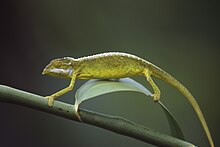 Seychelles tiger chameleon ( Archaius tigris )
Seychelles tiger chameleon ( Archaius tigris )- Seychelles tiger chameleon ( Archaius tigris ( Kuhl , 1820))
- Genus Bradypodion Fitzinger , 1843
- Bradypodion atromontanum Branch , Tolley & Tilbury , 2006
- Bradypodion caeruleogula Raw & Brothers , 2008
- Bradypodion caffer ( Boettger , 1889)
- Bradypodion damaranum ( Boulenger , 1887)
- Bradypodion dracomontanum Raw , 1976
- Bradypodion gutturale ( Smith , 1849)
- Bradypodion kentanicum ( Hewitt , 1935)
- Bradypodion melanocephalum ( Gray , 1865)
- Bradypodion nemoral Raw , 1978
- Bradypodion ngomeense Tilbury & Tolley , 2009
- Bradypodion occidentale ( Hewitt , 1935)
- Colorful dwarf chameleon ( Bradypodion pumilum ( Gmelin , 1789))
- Bradypodion setaroi Raw , 1976
- Bradypodion taeniabronchum ( Smith , 1831)
- Bradypodion thamnobates Raw , 1976
- Bradypodion transvaalense ( Fitzsimons , 1930)
- Desert dwarf chameleon ( Bradypodion ventral ( Gray , 1845))
- Genus Brookesia Gray , 1865
- Brookesia ambreensis Raxworthy & Nussbaum , 1995
- Brookesia antakarana Raxworthy & Nussbaum , 1995
- Brookesia bekolosy Raxworthy & Nussbaum , 1995
- Brookesia betschi Brygoo , Blanc & Domergue , 1974
- Brookesia bonsi Ramanantsoa , 1980
- Brookesia brunoi Crottini , Miralles , Glaw , Harris , Lima & Vences , 2012
- Brookesia brygooi Raxworthy & Nussbaum , 1995
- Brookesia confidens Glaw , Koehler , Townsend & Vences , 2012
- Brookesia decaryi Angel , 1939
- Brookesia dentata Mocquard , 1900
- Brookesia desperata Glaw , Koehler , Townsend & Vences , 2012
- Brookesia Ebenaui ( Boettger , 1880)
- Brookesia exarmata Schimmenti & Jesu , 1996
- Brookesia griveaudi Brygoo , Blanc & Domergue , 1974
- Brookesia karchei Brygoo , Blanc & Domergue , 1970
- Brookesia lambertoni Brygoo & Domergue , 1970
- Brookesia lineata Raxworthy & Nussbaum , 1995
- Brookesia micra Glaw , Koehler , Townsend & Vences , 2012
- Brookesia minima Boettger , 1893
- Brookesia perarmata ( Angel , 1933)
- Brookesia peyrierasi Brygoo & Domergue , 1974
- Brookesia ramanantsoai Brygoo & Domergue , 1975
- Brookesia stumpffi Boettger , 1894
- Brookesia superciliaris ( Kuhl , 1820)
- Brookesia therezieni Brygoo & Domergue , 1970
- Brookesia thieli Brygoo & Domergue , 1969
- Brookesia tristis Glaw , Köhler , Townsend & Vences , 2012
- Brookesia tuberculata Moquard , 1894
- Brookesia vadoni Brygoo & Domergue , 1968
- Brookesia valerieae Raxworthy , 1991
- Genus Calumma Gray , 1865
- Calumma amber Raxworthy & Nussbaum , 2006
- Calumma ambreense Ramanantsoa , 1974
- Calumma andringitraensis ( Brygoo , Blanc & Domergue , 1972)
- Calumma boettgeri ( Boulenger , 1888)
- Short-horned chameleon ( Calumma brevicorne ( Günther , 1879))
- Calumma capuroni ( Brygoo , Blanc & Domergue , 1972)
- Calumma crypticum Raxworthy & Nussbaum , 2006
- Calumma cucullatum ( Gray , 1831)
- Calumma fallax ( Mocquard , 1900)
- Calumma furcifer ( Vaillant & Grandidier , 1880)
- Calumma gallus ( Günther , 1877)
- Calumma gastrotaenia ( Boulenger , 1888)
- Calumma glawi Böhme , 1997
- Calumma globifer ( Günther , 1879)
- Calumma guibei ( Hillenius , 1959)
- Calumma guillaumeti ( Brygoo , Blanc & Domergue , 1974)
- Calumma hafahafa Raxworthy & Nussbaum , 2006
- Calumma hilleniusi ( Brygoo , Blanc & Domergue , 1973)
- Calumma jejy Raxworthy & Nussbaum , 2006
- Calumma malthe ( Günther , 1879)
- Calumma marojezense ( Brygoo , Blanc & Domergue , 1970)
- Calumma nasutum ( Duméril & Bibron , 1836)
- Calumma oshaughnessyi ( Günther , 1881)
- Parson's chameleon ( Calumma parsonii ( Cuvier , 1824))
- Calumma peltierorum Raxworthy & Nussbaum , 2006
- Calumma peyrierasi ( Brygoo , Blanc & Domergue , 1974)
- Tarzankhameleon ( Calumma tarzan Gehring , Pabijan , Ratsoavina , Köhler , Vences & Glaw , 2010)
- Calumma tsaratananense ( Brygoo & Domergue , 1968)
- Calumma tsycorne Raxworthy & Nussbaum , 2006
- Calumma vatosoa Andreone , Mattioli , Jesu & Randrianirina , 2001
- Calumma vencesi Andreone , Mattioli , Jesu & Randrianirina , 2001
- Calumma vohibola Gehring , Ratsoavina , Vences & Glaw , 2011
- Genus Chamaeleo Laurenti , 1768Ordinary chameleon , a typical representative of the real chameleons
- Basilisk chameleon ( Chamaeleo africanus Laurenti , 1768)
- Chamaeleo anchietae Bocage , 1872
- Chamaeleo arabicus Matschie , 1893
- Chamaeleo calcaricarens Böhme , 1985
- Veiled chameleon ( Chamaeleo calyptratus Duméril & Bibron , 1851)
- Common chameleon ( Chamaeleo chamaeleon ( Linnaeus , 1758))
- Lobe chameleon ( Chamaeleo dilepis Leach , 1819)
- Heel spur chameleon ( Chamaeleo gracilis Hallowell , 1842)
- Chamaeleo laevigatus Gray , 1863
- Chamaeleo monachus Gray , 1865
- Desert chameleon ( Chamaeleo namaquensis Smith , 1831)

- Chamaeleo necasi Ullenbruch , Krause & Böhme , 2007
- Chamaeleo senegalensis Daudin , 1802
- Chamaeleo zeylanicus Laurenti , 1768
- Genus Furcifer Fitzinger , 1843
- Furcifer angeli ( Brygoo & Domergue , 1968)
- Furcifer antimena ( Grandidier , 1872)
- Furcifer balteatus ( Duméril & Bibron , 1851)
- Furcifer belalandaensis ( Brygoo & Domergue , 1970)
- Furcifer bifidus ( Brongniart , 1800)
- Furcifer campani ( Grandidier , 1872)
- Furcifer cephalolepis ( Günther , 1880)
- Furcifer labordi ( Grandidier , 1872)
- Carpet chameleon ( Furcifer lateralis ( Gray , 1831))
- Furcifer major ( Brygoo , 1971)
- Furcifer minor ( Günther , 1879)
- Furcifer nicosiai Jesu , Mattioli & Schimmenti , 1999
- Giant chameleon ( Furcifer oustaleti ( Mocquard , 1894))
- Panther chameleon ( Furcifer pardalis ( Cuvier , 1829))
- Furcifer petteri ( Brygoo & Domergue , 1966)
- Furcifer polleni ( Peters , 1873)
- Furcifer rhinoceratus ( Gray , 1843)
- Furcifer timoni Glaw , Köhler & Vences , 2009
- Furcifer tuzetae ( Brygoo , Bourgat & Domergue , 1972)
- Furcifer verrucosus ( Cuvier , 1829)
- Furcifer viridis Florio , Ingram , Rakotondravony , Louis & Raxworthy , 2012
- Furcifer willsii ( Günther , 1890)
- Genus Kinyongia Tilbury , Tolley & Branch , 2006
- Kinyongia adolfifriderici ( Sternfeld , 1912)
- Kinyongia asheorum Necas , Sindaco , Korený , Kopecná , Malzona & Modrý , 2009
- Kinyongia boehmei ( Lutzmann & Necas , 2002)
- Kinyongia carpenteri ( Parker , 1929)
- Kinyongia excubitor ( Barbour , 1911)
- Kinyongia fischeri ( Reichenow , 1887)
- Kinyongia gyrolepis Greenbaum , Tolley , Joma & Kusamba , 2012
- Kinyongia magomberae Menegon , Tolley , Jones , Rovero , Marshall & Tilbury , 2009
- Kinyongia matschiei ( Werner , 1895)
- Kinyongia multituberculata ( Nieden , 1913)
- Kinyongia mulyai Tilbury & Tolley , 2015
- Kinyongia oxyrhina Klaver & Böhme , 1988
- Two-horned chameleon ( Kinyongia tavetana ( Steindachner , 1891))
- Kinyongia tenuis ( Matschie , 1892)
- Kinyongia uluguruensis ( Loveridge , 1957)
- Kinyongia uthmoelleri ( Müller , 1938)
- Kinyongia vanheygeni Necas , 2009
- Kinyongia vosseleri ( Nieden , 1913)
- Kinyongia xenorhina ( Boulenger , 1901)
- Genus Nadzikambia Tilbury , Tolley & Branch , 2006
- Nadzikambia baylissi Branch & Tolley , 2010
- Nadzikambia mlanjensis ( Broadley , 1965)
- Genus Palleon Glaw , Hawlitschek & Bernhard & Ruthensteiner , 2013
- Palleon lolontany ( Raxworthy & Nussbaum , 1995)
- Palleon nasus ( Boulenger , 1887)
- Genus Rhampholeon Günther , 1874
- Rhampholeon acuminatus Mariaux & Tilbury , 2006
- Rhampholeon beraduccii Mariaux & Tilbury , 2006
- Rhampholeon boulengeri Steindachner , 1911
- Rhampholeon bruessoworum Branch , Bayliss & Tolley , 2014
- Rhampholeon chapmanorum Tilbury , 1992
- Rhampholeon gorongosae Broadley , 1971
- Rhampholeon hattinghi Tilbury & Tolley , 2015
- Marshall's chameleon ( Rhampholeon marshalli Boulenger , 1906)
- Rhampholeon maspictus Branch , Bayliss & Tolley , 2014
- Rhampholeon moyeri Menegon , Salvidio & Tilbury , 2002
- Rhampholeon nchisiensis ( Loveridge , 1953)
- Rhampholeon nebulauctor Branch , Bayliss & Tolley , 2014
- Rhampholeon platyceps Günther , 1893
- Earth chameleon ( Rhampholeon spectrum ( Buchholz , 1874))
- Rhampholeon spinosus ( Matschie , 1892)
- Rhampholeon temporalis ( Matschie , 1892)
- Rhampholeon tilburyi Branch , Bayliss & Tolley , 2014
- Rhampholeon uluguruensis Tilbury & Emmrich , 1996
- Rhampholeon viridis Mariaux & Tilbury , 2006
- Genus Rieppeleon Matthee , Tilbury & Townsend , 2004
- Rieppeleon brachyurus ( Günther , 1893)
- Rieppeleon brevicaudatus ( Matschie , 1892)
- Rieppeleon kerstenii ( Peters , 1868)
- Rieppeleon robecchii ( Boulenger , 1891)
- Genus Trioceros Swainson , 1839
- Trioceros affinis ( Rüppell , 1845)
- Trioceros balebicornutus ( Tilbury , 1998)
- Striped chameleon ( Trioceros bitaeniatus ( Fischer , 1884))
- Trioceros camerunensis ( Müller , 1909)
- Trioceros chapini ( Witte , 1964)
- Trioceros conirostratus ( Tilbury , 1998)
- Combed chameleon ( Trioceros cristatus ( Stutchbury , 1837))
- Usambara three- horned chameleon ( Trioceros deremensis ( Matschie , 1892))
- Trioceros eisentrauti ( Mertens , 1968)
- Trioceros ellioti ( Günther , 1895)
- Trioceros feae ( Boulenger , 1906)
- Poroto three-horned chameleon ( Trioceros fuelleborni ( Tornier , 1900))
- Trioceros goetzei ( Tornier , 1899)
- Trioceros hanangensis Krause & Böhme , 2010
- Trioceros harennae ( Largen , 1995)
- Helmet chameleon ( Trioceros hoehnelii ( Steindachner , 1891))
- Trioceros incornutus ( Loveridge , 1932)
- Trioceros ituriensis ( Schmidt , 1919)
- Three-horned chameleon ( Trioceros jacksonii ( Boulenger , 1896))
- Johnston's chameleon ( Trioceros johnstoni ( Boulenger , 1901))
- Trioceros kinangopensis Stipala , Lutzmann , Malzona , Wilkinson , Godley , Nyamache & Evans , 2012
- Trioceros kinetensis ( Schmidt , 1943)
- Side- spiked chameleon ( Trioceros laterispinis ( Loveridge , 1932))
- Marsabit chameleon ( Trioceros marsabitensis ( Tilbury , 1991))
- Elephant- eared chameleon ( Trioceros melleri ( Gray , 1865))
- Mountain chameleon ( Trioceros montium ( Buchholz , 1874))
- Trioceros narraioca ( Necas , Modry & Slapeta , 2003)
- Trioceros ntunte ( Necas , Modry & Slapeta , 2005)
- Trioceros nyirit Stipala , Lutzmann , Malzona , Borghesio , Wilkinson , Godley & Evans , 2011
- Trioceros oweni ( Gray , 1831)
- Trioceros perreti ( Klaver & Böhme , 1992)
- Trioceros pfefferi ( Tornier , 1900)
- Four-horned chameleon ( Trioceros quadricornis ( Tornier , 1899))
- Rough mountain chameleon ( Trioceros rudis ( Boulenger , 1906))
- Trioceros schoutedeni ( Laurent , 1952)
- Trioceros schubotzi ( Sternfeld , 1912)
- Trioceros serratus ( Mertens , 1922)
- Trioceros sternfeldi ( Rand , 1963)
- Trioceros tempeli ( Tornier , 1899)
- Trioceros werneri ( Tornier , 1899)
- Trioceros wiedersheimi ( Nieden , 1910)
- ↑ a b Occurrence on the Comoros
- ↑ Rieppeleon robecchii is alternatively viewed as a subspecies of Rieppeleon kerstenii ( e.g. in the Reptile Database).
Keeping in the terrarium
Chameleons have been popular as terrarium animals in recent years due to their blaze of color. The maintenance effort for these sensitive animals is high. Wild-caught animals are often offered, but often die after a short period of time due to transport stress and illness.
Symbolic and mythological meaning
The proverbial chameleon has become a term for people who know how to adapt to any environment. This term can have both positive and negative connotations. In some cultures the chameleon stands for time, as its eyes, with the ability to look back, to the side and to the front at the same time, are a symbol of the unity of past, present and future.
The chameleon plays a particularly important role in African mythology. Just like the clever fox or the thieving magpie , the chameleons also have special properties:
- One aspect is the connection with death. Accordingly, the chameleon was the messenger of a message from the gods. They described the immortality of man. After they gave the chameleon the order, it immediately set off. However, it was not particularly fast, dawdled and consumed a lot of time eating. The gods got angry and hired a bird. However, in his message now was human mortality. The people got the message and do not believe the chameleon who arrives later no more a word about immortality. Some say that if the chameleon had been faster, humans would now be immortal. Therefore, many of the native people of Africa hate the animal. However, there are also tribes that forgive the chameleon since it is a slow animal anyway.
- Another quality that is said of the animal are magical healing powers. Here, chameleons are placed on the head of sick people and then waited to see how the patient reacts. The diagnosis is then made from the reactions. Another healing success is expected from dried chameleons, which are ground into powder and taken in a soup.
- The last aspect is evil forces. Some ethnic groups avoid chameleons because they fear bad luck. Another myth is that women shouldn't look at chameleons because no one else will marry them.
Others
- While some chameleons can live to be over 15 years old, various short-lived species also exist. Furcifer labordi from southwest Madagascar is the most short-lived terrestrial vertebrate on earth. The animals grow to sexual maturity in just two months, then have to quickly find a partner and reproduce before they die at four to five months of age.
literature
- Mark Carwardine : Extreme of Nature. G and J / RBA, Hamburg 2006, ISBN 3-937606-57-2 .
- Frank Glaw , Miguel Vences : A Field Guide to the Amphibians and Reptiles of Madagascar. Including Mammals and Freshwater Fish. 2nd Edition. Vences & Glaw, Cologne 1994, ISBN 3-929449-01-3 .
- Friedrich Wilhelm Henkel, Sebastian Heinecke: chameleons in the terrarium. Landbuch-Verlag, Hannover 1993, ISBN 3-7842-0493-7 .
- Charles JJ Klaver, Wolfgang Böhme : Chamaeleonidae (= Das Tierreich. Teilbd. 112). Walter de Gruyter & Co., Berlin et al. 1997, ISBN 3-11-015187-1 .
- Ingo Kober, Andreas Ochsenbein: Veiled chameleon and panther chameleon. Care, reproduction and way of life. Kirschner & Seufer Verlag, Karlsruhe 2006, ISBN 3-9808264-2-2 .
- Petr Nečas: chameleons. Colorful jewels of nature. 3rd improved and revised edition. Edition Chimaira, Frankfurt am Main 2004, ISBN 3-930612-02-X .
- Petr Nečas, Wolfgang Schmidt: Stubby-tailed chameleons. Miniature kites of the rainforest. The genera Brookesia and Rhampholeon. Edition Chimaira, Frankfurt am Main 2004, ISBN 3-930612-48-8 .
- Wolfgang Schmidt, Klaus Tamm, Erich Wallikewitz: Chameleons. Dragons of our time. 5th, completely revised and expanded edition. Natur-und-Tier-Verlag, Münster 2010, ISBN 978-3-86659-133-2 .
Individual evidence
- ↑ a b Chamaeleonidae in The Reptile Database ; accessed on March 28, 2015.
- ↑ Scott Moody, Zbyněk Rocek: Chamaeleo caroliquarti (Chamaeleonidae, Sauria): a new species from the Lower Miocene of Central Europe. In: Věstnik Ústředního ústavu geologického. Vol. 55, No. 2, 1980, ISSN 0042-4730 , pp. 85-92, digitized version (PDF; 8.87 MB) ( Memento from July 18, 2011 in the Internet Archive ).
- ↑ Torsten Schröer, Burkhard Thiesmeier (Ed.): Harenberg, Enzyklopädie der Tiere. More than 1400 animal species, families and orders in individual portraits. Harenberg-Lexikon-Verlag, Dortmund 1999, ISBN 3-611-00813-3 , p. 95.
- ↑ Dischner, H .: On the mode of action of the tongue in chameleons. In: Nature and People . No. 88 , 1958, pp. 320-324 .
- ^ Frank Glaw, Miguel Vences: A Field Guide to the Amphibians and Reptiles of Madagascar. 3. Edition. Vences & Glaw, Cologne 2007, ISBN 978-3-929449-03-7 .
- ↑ Andrea Mustain: Some spot color: Meet the world's tiniest chameleon. On Msnbc.com - Science . Retrieved November 15, 2014.
- ↑ Dpa: Chameleon saliva 400 times tougher than human, In: Hamburger Abendblatt, June 21, 2016, p. 20
- ↑ zeit.de: Right: Do chameleons change their color in order to adapt to their surroundings?
- ↑ Jérémie Teyssier et al .: Photonic crystals cause active color change in chameleons. Nature Communications 6: 6368 (2015), doi: 10.1038 / ncomms7368 .
- ↑ a b Frank Glaw, Oliver Hawlitschek, Bernhard Ruthensteiner: A new genus name for an ancient Malagasy chameleon clade and a PDF-embedded 3D model of its skeleton. In: Salamandra . Vol. 49, No. 4, 2013, pp. 237-238, online .
- ^ Krystal A. Tolley, Ted M. Townsend, Miguel Vences: Large-scale phylogeny of chameleons suggests African origins and Eocene diversification. In: Proceedings of the Royal Society of London. Series B: Biological Sciences. Vol. 280, No. 1759, 2013, 20130184, doi : 10.1098 / rspb.2013.0184 .
- ↑ Kristopher B. Karsten, Laza N. Andriamandimbiarisoa, Stanley F. Fox, Christopher J. Raxworthy: A unique life history among tetrapods: An annual chameleon living mostly as an egg. In: Proceedings of the National Academy of Sciences of the United States of America . Volume 105, No. 26, 2008, pp. 8980-8984, doi : 10.1073 / pnas.0802468105 .



